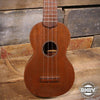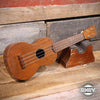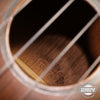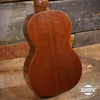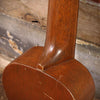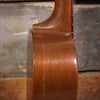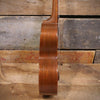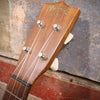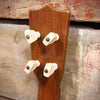Vintage Martin Ukulele style 0 in fair condition due to a crack on the side of the body. You can see the crack in photos 5, 6 and 7. This was repaired by our Luthier so the Ukulele is solid and ready to be strummed. Besides the crack the rest of the Ukulele is in very good/excellent condition for its age. About Vintage Martin Ukuleles: Martin Ukulele Models: Martin 0m, 1m, 2m, 3m, 0k, 1k, 2k, 3k, 5k Ukuleles were in highest production from 1916 to the 1930's, though still manufactured in quantity until 1965. Production quantities during some periods were as great as Martin guitars. Martin ukes are considered to be the best for craftsmenship and sound. The Koa wood models are more collectible than mahagony models. The fancier style 5 models are worth more than plainer styles 0 to 3. All sizes are collectible. The first Martin ukes, built in 1916, have serial numbers ranging from one to less than 200. Ukes made after 1916 do not have serial numbers and must be dated by specification changes. For example, in 1962 Martin added "made in usa" to the inside stamp. Ukes have the Martin stamp on the back of the peghead until 1935. Peghead decals do not appear in catalog photos till after WWII. Total Body Body Scale Style Length Length Width Length Soprano (std) 21" 9 7/16" 6 3/8" 13 5/8" Concert 23 1/4" 11" 7 5/8" 14 3/4" Tenor 26 1/4" 12 1/16" 8 15/16" 17" Baritone 30 11/16" 14" 10" 20 1/8" Martin ukuleles produced in greatest numbers in the smallest soprano size, but concert and tenor sizes were available circa 1922. Concert and tenor models were available in all the following styles, with the exception of Style 0, which was produced only as a soprano. Custom order ukuleles, while rare, were available upon request, and may have combined features from various styles. Martin Style 0 Uke specs: The most basic of Martin ukes. Mahogany body with no body binding and nothing fancy. Discontinued in the 1970s. Introduced in 1922. Mahogany body. No body binding. 12 fret rosewood fingerboard with bar frets. C.F.Martin & Co. on back of headstock. Small dot inlays. Rosewood friction pegs. 1927: Ebony nut and nickel plated pegs 1932: Decal logo on front of headstock 1934: T frets 1970s: discontinued. Recently the S-O (made in Mexico) has been introduced.









